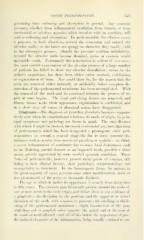Page 527 - My FlipBook
P. 527
GOUTY PERICEMENTITIS. 525
governing bone softening and absorption in general. Any constant
pressnre, whether from infiamniatory exntlation, from tnmors, or from
mechanical or infective agencies which interfere with its nntrition, will
lead to softening and absorption. In pericementitis the effusion exerts
a pressnre in both directions, toward the cementum and toward the
alveolar walls ; as the latter are spongy in character, they readily yield
to the absorptive process. Should the pressure continue indefinitely,
or until the alveolar walls become denuded, caries or necrosis would
inevitably result. Fortunately this termination is seldom if ever seen :
the most careful examination of the alveolar process of a large number
of patients has failed to show any alveolar denudation ; never, in the
writer's experience, has there been either caries, necrosis, exfoliation,
or sequestration of bone. Nor could there be, for the reason that the
teeth are removed either naturally or artificially before complete de-
struction of the pericemental membrane has been accomplished. With
the removal of the teeth and its associated irritants the process of re-
})air at once begins. The dead and dying tissues are removed, and
fibrous tissues make their appearance, organization is established, and
in a short time all traces of abnormal action have disappeared.
Diagnosis.—The diagnosis of pyorrhea alveolaris becomes compara-
tively easy when its constitutional relations, its mode of origin, its prin-
cipal symptoms and pathology are borne in mind. The only diseases
with which it might be (indeed, has been) confounded are, first, that form
of pericementitis which has been designated a ptyalogenic calcic peri-
cementitis ; or, second, a general gingivitis due to some systemic dis-
turl,)ance such as results from mercurial ptyalisni or syphilis ; or, third,
a severe inflammation of continuity due to some local disturbance such
as an ill-fitting partial denture or an imjiaeted tooth, possibly a third
molar, greatly aggravated by some morbid systemic condition. These
forms of pericementitis, however, present many points of contrast, dif-
fering in their clinical history, their pathology, symptomatology and
susceptibility to treatment. In the hematogenic forms the patient, in
the great majority of cases, presents some other manifestations more or
less pronounced, of the gouty or rheumatic diathesis.
The age at which it makes its appearance is usually from thirty-five
to fifty years. The extreme pain frecjuently present around the roots of
one or more teeth in the early stages, and before there is any evidence of
a gingivitis ; the deviation in the position, and the apjianmt or actual
elevation of the tooth, with response to pressiu'c ; the swelling or thick-
ening of the pericemental mend)rane ; slight tuuiefaction of the gum
with deep red or ])iu'plisli color oj)j)osite the a[)ieal end of the root of
the tooth or teeth affected—and all of this before the a])])earance of pus ;
the isolated character of" the iullaminatiou, being usuallv confined to one


